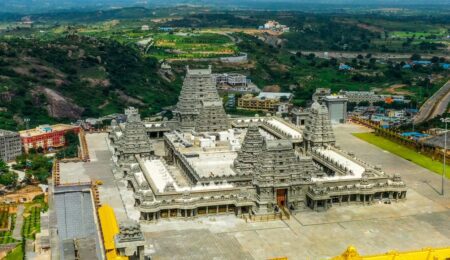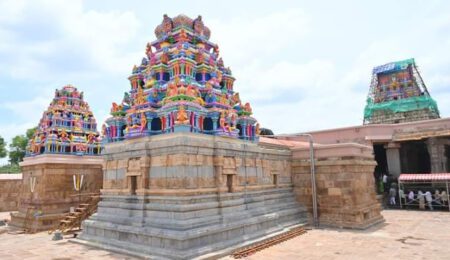Importance of Chaturmas in Hinduism – Rituals, Significance, and Spiritual Practices
Chaturmas : Introduction
Hinduism is a way of life that beautifully weaves spirituality with seasonal cycles, discipline with devotion, and rituals with deep meaning. Among its many sacred observances, Chaturmas holds a special place. Known as the “four holy months,” Chaturmas is considered highly auspicious, a period where the spiritual atmosphere becomes charged with devotion, penance, and divine grace.
Starting from Ashadha Shukla Ekadashi (Devshayani Ekadashi) and ending on Kartik Shukla Ekadashi (Prabodhini Ekadashi), these four months are believed to be the time when Lord Vishnu goes into yogic sleep (Yoga Nidra). Devotees across India immerse themselves in fasting, puja, scripture reading, and intense spiritual practices to seek blessings and inner growth.
Chaturmas is not just about rituals; it’s a journey of discipline, devotion, and self-transformation. It teaches us to pause, slow down, and align with nature’s rhythm. From avoiding marriages and new beginnings to observing strict fasts and celebrating some of the most important Hindu festivals, Chaturmas inspires every devotee to embrace simplicity, humility, and bhakti.
In this article, we will explore the meaning, origin, rituals, significance, festivals, spiritual practices, and modern relevance of Chaturmas – making it a complete guide to one of Hinduism’s most profound observances.
Meaning & Origin of Chaturmas
The term Chaturmas literally translates to “four months.” It begins on Devshayani Ekadashi (the 11th day of the bright fortnight in Ashadha month, usually June–July) and ends on Prabodhini Ekadashi (the 11th day of the bright fortnight in Kartik month, usually October–November).
According to Hindu scriptures and Puranas, Lord Vishnu, the preserver of the universe, goes into Yoga Nidra (cosmic sleep) during this time, resting on the serpent Shesha in the cosmic ocean (Kshirasagara). His sleep symbolizes a pause in worldly activities, urging devotees too to slow down, practice penance, and deepen spiritual practices.
The Padma Purana and Skanda Purana describe Chaturmas as the period where humans can progress spiritually by observing vrat (fast), chanting mantras, and performing good deeds. It is also said that the Devas (gods) rest during this time, and hence, worldly auspicious ceremonies like weddings, housewarmings, or new ventures are postponed.
This tradition has roots not only in religion but also in practicality. The monsoon season makes travel difficult, so saints, sages, and pilgrims would stay in one place, using the time for satsang, discourses, and teaching disciples. Over centuries, this evolved into a deeply spiritual observance celebrated across India.
Astrological & Seasonal Importance of Chaturmas
Chaturmas coincides with the monsoon season in India – a time when the earth is replenished with rains, rivers overflow, and nature blossoms. Astrologically, it begins when the Sun enters the zodiac sign of Cancer (Karka Rashi) and spans until it reaches Libra (Tula Rashi).
This seasonal and astrological timing is significant:
- For Saints and Sages: Heavy rains made traveling difficult, so ascetics and monks would halt their wandering and stay in one place, giving discourses and guiding devotees. This practice still continues in many traditions.
- For Devotees: Monsoon often brought diseases and scarcity in ancient times. Observing fasting, eating sattvic food, and practicing discipline during Chaturmas was also a way to protect health.
- Symbolism of Rest: Just as nature rests and rejuvenates during the rains, Chaturmas symbolizes a pause for humans – encouraging reflection, renewal, and spiritual focus.
Thus, Chaturmas beautifully integrates astrology, health, ecology, and spirituality into one sacred observance.
Rituals & Practices of Chaturmas
Chaturmas is filled with diverse rituals, fasts, and spiritual practices. While customs vary regionally, certain observances remain common.
Daily Practices
- Fasting: Devotees observe fasts on specific days, especially Ekadashi vrat.
- Puja & Bhajans: Daily worship of Lord Vishnu, Shiva, and Devi with bhajans, kirtans, and arti.
- Scripture Reading: Reading sacred texts like the Bhagavad Gita, Ramayana, Bhagavata Purana, and Vishnu Sahasranama.
- Charity: Donating food, clothes, and money to the needy.
- Self-Restraint: Avoiding meat, alcohol, and even certain vegetables like onion, garlic, and brinjal.
Major Observances
- Ekadashi: Each Ekadashi within Chaturmas is considered highly significant, especially Devshayani Ekadashi and Prabodhini Ekadashi.
- Shravan Month (July–August): Known for fasting and Shiva puja. Mondays of Shravan (Shravan Somvar) are particularly sacred.
- Krishna Janmashtami: Celebrating Lord Krishna’s birth with fasting, midnight puja, and devotional singing.
- Ganesh Chaturthi: Worship of Lord Ganesha with grandeur, devotion, and community celebrations.
- Navratri: Nine days dedicated to Goddess Durga with fasting, garba, and rituals.
- Diwali: The festival of lights, celebrated towards the end of Chaturmas.
Why Marriages & Ceremonies are Avoided
Since gods and goddesses are believed to be resting, auspicious activities like weddings, housewarmings, and new ventures are traditionally avoided. Instead, the focus shifts to inner growth and bhakti.
Spiritual Significance of Chaturmas
Beyond rituals, Chaturmas carries profound spiritual meaning. It is a time for self-discipline, purification, and devotion.
- Inner Discipline: Fasting and restrictions train the mind to control desires.
- Mental Purification: Bhajans, japa, and satsang cleanse negative thoughts.
- Devotion: Worshipping Vishnu, Shiva, and Devi strengthens one’s bhakti.
- Penance & Sadhana: Saints emphasize tapas (austerity) and meditation during this time.
- Detachment: Avoiding pleasures like rich food, luxury, and celebrations helps cultivate vairagya (detachment).
Spiritually, Chaturmas is a period where the doors of heaven are said to open wider, and sincere devotees can progress faster toward liberation (moksha).
Festivals Celebrated in Chaturmas
Chaturmas is unique because it encompasses some of Hinduism’s most important festivals.
Here’s a month-wise overview:
| Month (Lunar) | Major Festivals in Chaturmas |
|---|---|
| Ashadha (June–July) | Devshayani Ekadashi, Guru Purnima |
| Shravan (July–August) | Nag Panchami, Shravan Somvar, Krishna Janmashtami |
| Bhadrapada (August–September) | Ganesh Chaturthi, Rishi Panchami, Anant Chaturdashi |
| Ashwin (September–October) | Navratri, Dussehra |
| Kartik (October–November) | Karva Chauth, Dhanteras, Diwali, Prabodhini Ekadashi |
This combination of vrat and utsav makes Chaturmas a spiritually enriching period, blending fasting, penance, and joyous celebrations.
Role of Saints & Sages in Chaturmas
For centuries, Chaturmas has been a special period for saints, sages, and spiritual leaders.
- Staying in One Place: Saints traditionally stop traveling and reside in one ashram or town.
- Discourses (Upadesh): They deliver sermons, explain scriptures, and guide devotees.
- Satsang: Spiritual gatherings filled with bhajans, chanting, and discussions.
- Vrat Katha: Narrating stories of devotees who gained blessings through Chaturmas vrat.
This tradition ensures that spiritual wisdom is passed on, and devotees get the opportunity to learn and practice under the guidance of enlightened masters.
Chaturmas Vrat & Its Benefits
The Chaturmas vrat is a special observance where devotees take specific vows for the entire four months.
How It Is Observed
- Avoiding certain foods like onion, garlic, leafy vegetables, or sweets.
- Practicing vegetarianism and sattvic diet.
- Daily chanting of mantras and Vishnu Sahasranama.
- Engaging in meditation and seva (service).
Benefits of Chaturmas Vrat
- Physical Health: Light, sattvic food aids digestion during monsoon.
- Mental Peace: Regular prayer and meditation reduce stress.
- Spiritual Growth: Bhakti, fasting, and scripture reading bring one closer to the divine.
- Karmic Cleansing: Charity, self-restraint, and seva help balance past karma.
Modern Relevance of Chaturmas
In today’s fast-paced world, Chaturmas offers timeless lessons. Even if one cannot follow traditional vrat strictly, the essence can still be practiced.
- Fasting: Can be simplified to intermittent fasting or sattvic eating.
- Meditation: Just 10–15 minutes of daily meditation can align with Chaturmas spirit.
- Minimalism: Reducing excess consumption and practicing eco-friendly habits.
- Charity: Helping the needy, volunteering, or donating.
- Digital Fasting: In modern times, limiting social media use can be a Chaturmas practice.
Thus, Chaturmas is as relevant today as it was centuries ago – guiding us towards simplicity, balance, and spirituality.
Frequently Asked Questions about Chaturmas
Q1. What is Chaturmas in Hinduism?
Chaturmas refers to the four holy months in Hinduism, from Ashadha Shukla Ekadashi to Kartik Shukla Ekadashi. During this time, Lord Vishnu is believed to be in Yoga Nidra (cosmic sleep), and devotees focus on penance, fasting, and devotion.
Q2. Why are marriages not done in Chaturmas?
Marriages and new ventures are avoided in Chaturmas because it is believed that gods and goddesses rest during this period. Instead, the time is dedicated to prayer, penance, and spiritual upliftment.
Q3. Which festivals fall in Chaturmas?
Many major Hindu festivals are celebrated during Chaturmas, including Guru Purnima, Nag Panchami, Krishna Janmashtami, Ganesh Chaturthi, Navratri, Dussehra, Karva Chauth, Diwali, and Prabodhini Ekadashi.
Q4. What are the benefits of observing Chaturmas Vrat?
Observing Chaturmas Vrat is believed to bring:
- Physical benefits through sattvic (pure) food and fasting.
- Mental peace through meditation and prayer.
- Spiritual growth through devotion, charity, and penance.
Q5. What is the spiritual significance of Chaturmas?
Chaturmas symbolizes self-discipline, penance, and devotion. It is considered a time of purification, inner transformation, and spiritual upliftment dedicated to Lord Vishnu and Lord Shiva.
Conclusion
Chaturmas is not just a period of rituals; it is a transformative journey. It invites devotees to embrace discipline, devotion, and spiritual practices. Through fasting, puja, satsang, and festivals, one learns the values of self-control, simplicity, and inner purity.
As Lord Vishnu rests in Yoga Nidra, devotees too rest from worldly distractions and focus inward. By observing Chaturmas, one not only gains divine blessings but also achieves peace, prosperity, and spiritual growth.
In essence, Chaturmas is a divine reminder that true happiness lies not in material pursuits but in devotion, discipline, and harmony with the eternal self.




Leave a Comment